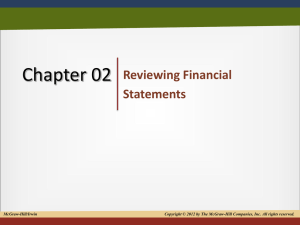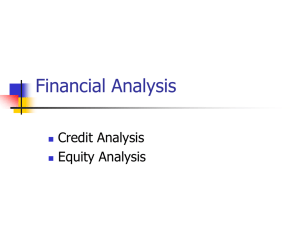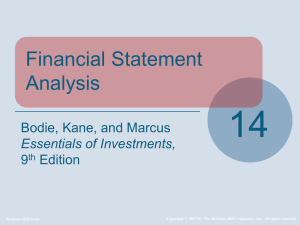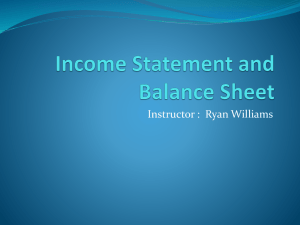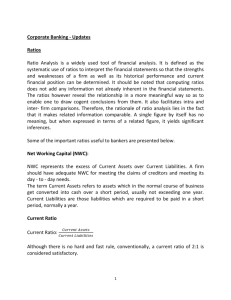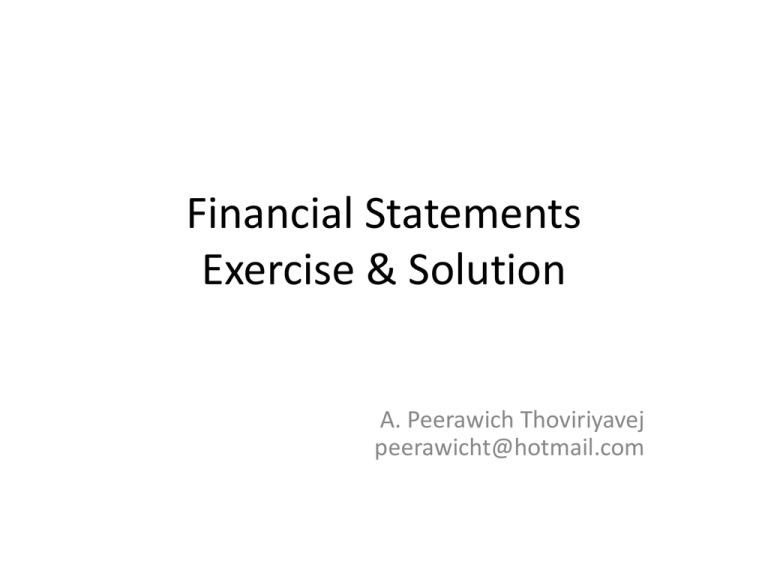
Financial Statements
Exercise & Solution
A. Peerawich Thoviriyavej
peerawicht@hotmail.com
Income Statement
Constructing an Income Statement
Use the following information to construct an income statement for Gap, Inc. (GPS).
The Gap is a specialty retailing company that sells clothing, accessories, and personal
care products under the Gap, Old Navy, Banana Republic, Piperlime, and Athleta brand
names. Use the scrambled information below to calculate the firm’s gross profits,
operating income, and net income for the year ended January 31, 2009. Calculate the
firm’s earnings per share and dividends per share.
Income Statement
Income Statement
Evaluating a Firm’s EPS
• EPS = Net income÷ Number of shares
outstanding
• Example 1: A firm reports a net income $90 million and has 35
million shares outstanding, what will be the earnings per
share (EPS)?
• EPS = Net income ÷ Number of shares
= $90 million ÷ $35 million
= $2.57
Income Statement: Check Yourself
Reconstruct the Gap’s income statement assuming the firm is able to cut its
cost of goods sold by 10% and where the firm pays taxes at 40% tax rate.
What is the firm’s net income and earnings per share?
Picture the IS
Revenues
Less: Cost of goods sold
Less: Operating expenses
Equals Gross
profit
Equals: net
Operating income
Less: Interest expense
Equals: earnings
Before taxes
Less: Income taxes
Equals:
NET INCOME
Finishing the Math
Revenues = $14,526,000,000
Less: Cost of goods sold
= $8,171,100,000
Less: Operating expenses
=$3,899,000,000
Less: Interest expense
=$1,000,000
Less: Income taxes (40%)
=$9,819,600,000
Equals: profit
=$6,354,900,000
Equals: net
Operating income
=$2,455,900,000
Equals: earnings
Before taxes
=$2,454,900,000
Equals:
NET INCOME
=$1,472,940,000
Conclusion
• The firm is profitable since it earned net
income of $1,472,940,000.
• The shareholders were able to earn $2.06 per
share.
New EPS:= net income ÷ #of shares
= $1,472,940,000 ÷ 716,296,296
= $2.06
The
Balance
Sheet
Balance Sheet
Constructing a Balance Sheet
Construct a balance sheet for Gap, Inc. (GPS) using the following list of jumbled
accounts for January 31, 2009. Identify the firm’s total assets and net working capital:
Balance Sheet
The Balance Sheet
Speaking in Finance….
Balance Sheet: Check Yourself
Reconstruct the Gap’s balance sheet to reflect the repayment of $1 billion in
short-term debt using a like amount of the firm’s cash. What is the balance for
total assets and current liabilities?
Our New Balance Sheet
Cash
Inventories
Other current
assets
756,000,000
1,506,000,000
743,000,000
Current liabilities
1,158,000,000
Total current
assets
3,005,000,000
Total current
liabilities
1,158,000,000
Net Property,
Plant and
equipment
2,993,000,000
Long-term
liabilities
1,019,000,000
Other long-term
assets
626,000,000
Common Equity
4,387,000,000
Total Assets
$6,564,000,000
Total Liabilities
and Equity
$6,564,000,000
Conclusion
• We can make the following observations from Gap’s Balance
sheet:
– The total assets of $6,564,000,000 is financed by
a combination of current liabilities, long-term
liabilities and owner’s equity. Owner’s equity
accounts for $4,387,000,000 of the total.
– The firm has a healthy net working capital of
$1,847,000,000 (3,005,000,000 minus
1,158,000,000).
Cash Flow Statement
Recall:
• Source of cash is any activity that brings cash
into the firm. For example, sale of equipment.
• Use of cash is any activity that causes cash to
leave the firm. For example, payment of taxes.
Require Financial
Statement:
Balance Sheet
Cash Flow Analysis
• Why did the cash balance decline by $4.5
million from 2009 to 2010?
1.Accounts receivable increased by $22.5 million
representing an increase in uncollected cash
from credit sales. Thus it represents $22.5m of
use of cash to invest in accounts receivable.
Cash Flow Analysis (cont.)
2. Inventory increased by $148.50 million
indicating use of cash to procure inventory.
3. Equipment increased by $175.50 million
indicating use of cash to invest in equipment.
In general,
– an increase in an asset account = use of cash
Cash Flow Analysis (cont.)
4. Accounts Payable, credit extended to the firm,
increased by $4.5million. Thus source of cash
increased by $4.5million due to accounts
payable.
5. Long-term debt increased by $51.75 million
indicating a source of cash.
6. Short-term debt decreased by $9 million
indicating use of cash to pay off the debt.
Cash Flow Analysis (cont.)
7. Retained earnings increased by $159.75
million representing a source of cash to the
firm from the firm’s operations.
In general,
– An increase in a liability account = source of cash
Cash Flow Analysis (cont.)
• Change in cash balance = Sources of cash –
Use of Cash = $216 - $220.50 = -$4.50
Sources of Cash
Uses of Cash
Increase in Accounts Payable
= $4.50
Increase in Accounts Receivable
$22.50
Increase in long-term debt
=$51.75
Increase in inventory =
$148.50
Increase in retained earnings =
$159.75
Increase in net plant and
equipment = $40.50
Decrease in short-term notes =
$9
Total Sources of cash =
$216.00
Total Uses of cash = $220.50
Cash Flow Analysis (cont.)
• An analysis of H.J. Boswell’s operations reveals the following
for 2010:
– The firm used more cash than it generated,
resulting in a deficit of $4.5 million
– The primary source of cash flow was retained
earnings ($159.75 million) followed by long-term
debt ($51.75 million)
– The largest use of cash was for acquiring inventory
at $148.5 million.
Cash Flow Analysis Summary
Sources of Cash
Uses of Cash
Decrease in an asset
account
Increase in an asset
account
Increase in a liability
account
Decrease in a liability
account
Increase in an owner’s
equity account
Decrease in an owners’
equity account
H.J. Boswell,
Inc.
Statement of
Cash Flows
Interpreting the SCF
You are in your second rotation in the management training program at a firm that finance new start up and
your supervisor calls you into her office on Monday morning to discuss your next training rotation. When you
enter her office you are surprised to learn that you will be responsible for compiling a financial analysis of new
venture. Thus, your boss askes you to practice with this Chesapeake Energy Inc. (CHK). Your boss suggests that
you begin your analysis by reviewing the firm’s cash flow statements for 2004 through 2007 (found below):
Analysis
Your Verdict
Source:
Copyright © 2011 Pearson Prentice Hall. All rights reserved.




